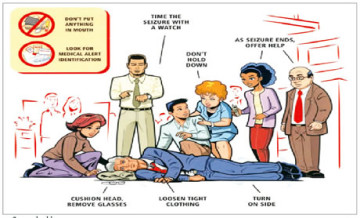pilepsy is curable, see the doctor!
Mary, a woman in her 40s, narrates her story. “When I resumed at the media house where I was posted to do my primary assignment as a 22-year-old youth corps member, it was the best thing that could happen to me, what with the monthly extra allowance I got. It was approximately 95 per cent of the stipend the Federal Government was paying corps members then. So, life was good.
“My fiancé only knew what I told him about myself, as I withheld the most vital information about my health, fearing that it could make him change his mind if he knew that I was epileptic.
“I had epileptic seizure once every month, but he didn’t know about it. We married after my service year and I became pregnant. Six weeks into the pregnancy, I had a seizure. It was late in the night.
“Being ignorant of what was really happening, my husband called on neighbours to help. The neighbours, mostly adults, recognised my symptoms and did everything they could to stop me from injuring myself. As I came out of the seizure, I started bleeding and the doctor later confirmed that I had lost the baby.
“He also explained to my husband that I was epileptic, which really angered him. He was angry because I kept the information from him. He simply walked out of the union and that was it.”
Now a single mother of a 10-year-old boy whom she had through a casual relationship, Mary says she wished she knew better than she did when she was growing up.
She quips, “But then, what do you expect from a youngster when even my parents talked about my condition in low tones, guarding the secret from neighbours and distant relations. Worse still, I didn’t know any other person who had epilepsy when I was growing up; nor do I know anyone who does now. It is simply a dark world that people with the disorder and their relations prefer to shield from the prying world.”
According to the World Health Organisation, about 50 million people worldwide have epilepsy; and nearly 90 per cent of them are found in developing regions, of which Nigeria is one. And though epilepsy responds to treatment about 70 per cent of the time, about three-fourths of affected people in developing countries do not get the treatment they need.
Worse still, WHO says, people with epilepsy and their families can suffer from stigma and discrimination, hence the secrecy that surrounds it, which sometimes prevents people living with the disorder from seeking medical help.
A psychiatrist with the Federal Medical Centre, Bida, Niger State, Dr. Ladipo Adepoju, defines epilepsy as a chronic neurological disorder that affects people of all ages.
“It is characterised by recurrent seizures, which are physical reactions to sudden, usually brief, excessive electrical discharges in a group of brain cells,” Adepoju says.
He adds, “Different parts of the brain can be the site of such discharges. In other words, it means that seizure is the action, while epilepsy is the diagnosis or the disorder. It can be caused by several things in children, such as birth traumas, childhood infections of the central nervous system, congenital malformations or high fevers.”
He warns that it could also be a genetic disorder; while in older people, injuries from head trauma, cerebro-vascular disease, alcohol, stimulant drugs and side effects of some drugs could also cause seizures.
Experts say six out of 10 cases of epilepsy have no known cause. “It is called idiopathic epilepsy,” WHO says.
Seizures can vary from the briefest lapses of attention or muscle jerks, to severe and prolonged convulsions. Seizures can also vary in frequency, from less than one per year to several per day.
Characteristics of seizures vary and depend on where in the brain the disturbance first starts, and how far it spreads. Temporary symptoms can occur, such as loss of awareness or consciousness, and disturbances of movement, sensation (including vision, hearing and taste), mood or mental function. People with seizures tend to sustain injuries such as fractures and bruising; and they are disposed to developing higher rates of other diseases or psycho-social issues.
A neurosurgeon with the Neurology Unit, Department of Medicine, University of Ilorin Teaching Hospital, Dr. Emmanuel Sanya, says though epilepsy is the commonest non-infectious chronic neurological condition encountered in general practice, it is a complex disorder that requires specialised knowledge for correct diagnosis, classification and treatment.
Sadly, most sufferers are absolutely unaware that epilepsy is a medical condition that can be treated and cured. Adepoju says it is not a demonic affliction that demands ‘deliverance.’ Rather, he counsels, patients should be taken to see a neurologist, who has been trained to identify and treat the disorder.
And, contrary to the old myth, epilepsy is not contagious. “It can be managed. Through adequate and consistent compliance with medications, an affected person can be seizure-free for about four years at a stretch. When this is achieved, the attending physician can confidently conclude that the patient has been cured of the disorder,” Adepoju assured.
Epilepsy is one of the world’s oldest recognised conditions, but fear, misunderstanding, discrimination and social stigma have surrounded it for centuries. Some of the stigma continues today and can impact the quality of life for epileptics and their families.
And where medical care is not sought, epilepsy increases a person’s risk of premature death by about two to three times, compared to the general population.
PUNCH.








